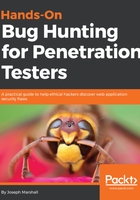
Setting Up Your Environment – Tools To Know
All of the tools we'll use in this book will be free – you shouldn't need to purchase anything outside of this work to recreate the walk-throughs. In the survey of other security software not used directly in our engagements in Chapter 12, Other Tools, there will be a discussion of other technologies (paid and free) you can leverage for extra functionality.
Here's a brief overview of some of the technologies we will be using:
- Burp Suite is a versatile program that can intercept web traffic (Burp Proxy), trigger application information submission (Burp Intruder), scan input against malicious code snippets (Burp Scanner), and – with the possibilities offered by extensions – a multitude of other things. We'll go over both using the native Burp functionality as well as how to incorporate simple extensions. Some of the paid functionalities, such as Burp Scan, will only receive an overview, in favor of focusing on the features available in the free version.
- Nmap, sqlmap, wfuzz, arachnid, and other CLI programs are great for their ability to be assembled into larger workflows, feeding information into adjacent tools (Burp and others), kicking off other automation, or consistently visualizing a target's attack surface.
- Deliberately vulnerable web applications are a different category of tooling – less for use in an actual pentesting engagement and designed more to either test out new ideas or calibrate an existing method or technology for those times when you need to return a positive result for a specific vulnerability. We'll be doing both with our use of deliberately vulnerable web apps, such as Google Gruyere, Target Range, DAMN vulnerable web app, and others. You can find a list of more DVWA in the sites section of Chapter 13, Going Further.
While we'll be going through the setup for these tools as we use them, it's still a good idea to poke around their installation and documentation pages. Because of their depth, many of these tools will have useful functionalities that we simply won't be able to completely cover in the course of our work. We'll also only skim the surface of tools not specific to security—the note—taking, logging, and other general productivity functionality represented by those apps can easily be replaced by whatever analogue you're most comfortable with.